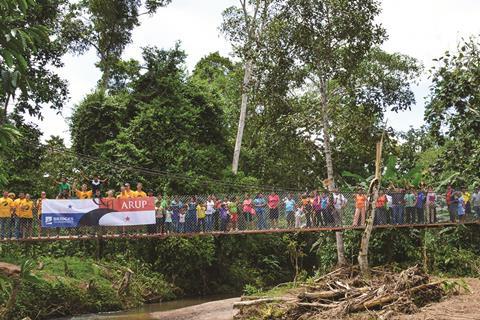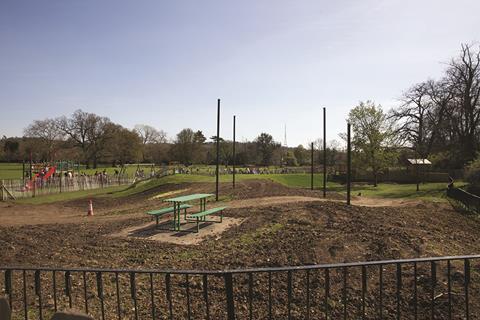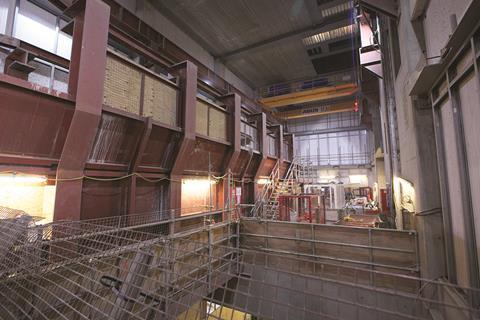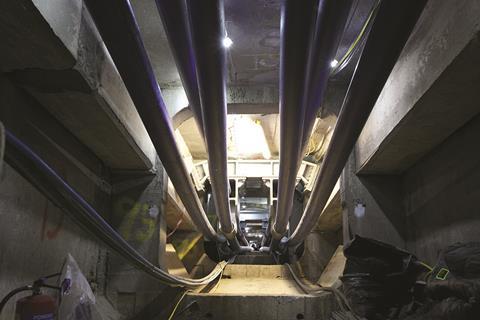This year’s awards showcase the diverse and innovative nature of projects taking place in the UK’s capital
This year’s crop of ICE London Engineering Awards winners closely reflects the diversity of projects taking place in the capital.
A huge amount of work is taking place on the Underground to cope with ever growing passenger numbers and interface smoothly with Crossrail. And the numbers of people using the London Overground have increased so dramatically since the 2011 improvements that capacity has had to be upped by 25% by putting in the infrastructure to run longer trains.
There have been several significant office buildings completing in London in the past year with many more in the pipeline - and this year’s building winner busts the traditional office typology both architecturally and technically.
Large sums are being spent on water infrastructure, most notably the Thames Tideway which is gearing up for construction to start. An alternative solution to managing rain water runoff is a winner of a special award and could be a model for other flood mitigation schemes.
And roads are represented among the winners - Hammersmith Flyover, which needed emergency repairs in 2012, is being made fit for purpose for the next 60 years with some challenging engineering work.
Organised by the Institution of Civil Engineers (ICE) in association with Topcon, there was a shortlist of 17. A panel of expert judges spent two days travelling around London to assess each entry. The awards were held last night at a ceremony at the home of the ICE, One Great George Street in Westminster. Here is a round-up of the winners.

ICE Building Award
Believe in Better Building, entered by Arup Associates
Broadcaster Sky’s new office and training facility has the distinction of being the UK’s first multi-storey commercial office to be built with an engineered timber frame. Sky wanted the building designed and constructed in a year. A glulam frame and cross laminated timber floors was proposed by Arup Associates as a way of meeting the demanding programme. Frame supplier B&K Structures was involved in the design at concept stage so contractor Mace could hit the ground running when the contract was let. Two storey high insulated timber facade cassettes provide U-values and airtightness levels better than Passivhaus standards. The finished building is light and airy with an open stair running the full height of the building to promote social interaction between floors. The judges liked the collaborative approach of the team saying: “Innovation and sustainability – it’s all there. The team came up with a design and built it very quickly which couldn’t have been done without close collaboration. They have created a fantastic building; the client liked it so much they are using the same system and project team for their next two projects.”

Designed in London
Panama Ciricito Bridge, entered by Arup
The charity Bridges to Prosperity specialises in providing footbridges to poor communities cut off from services and markets by impassable rivers. They have built over 200 bridges to date and Arup has developed a standardised suspension bridge making it easier, cheaper and safer to build the next generation of crossings. The solution consists of a tool, aptly named BridgeTOOL, which includes all the information to design and build a bridge to suit specific locations. Arup tested out the tool by sending a team of its engineers out to Ciricito in the Panamanian jungle to build a 46m long suspension bridge in just 12 days. The bridge was built with the help of the local community largely using hand tools in wet, muddy conditions. Arup introduced a temporary A frame solution to erect the suspension towers which is safer and faster than scaffolding. The new bridge now means over 1000 people have safe access to schools, healthcare and markets. The judges said: “Arup’s young engineers will have memories for life of this inspirational project which has transformed the lives of a community. They built it with limited power and mostly manual labour in difficult conditions and managed to transfer Arup’s health and safety culture to the jungle.”

Greatest contribution to London
London Overground Capacity Improvement Programme, entered by London Overground, Transport for London
The East London section of the London Overground is a great success story with passenger numbers rocketing since the line was revamped in 2011. These increased passenger numbers meant capacity enhancements were needed with the mayor setting a deadline of December 2014. The extra capacity has been created by increasing the length of the trains from four to five cars. This involved the delivery of a complex programme of platform lengthening, train stabling, signalling upgrades and maintenance facilities for the longer trains, a job that had to be done in just 20 months. A new depot has been built on contaminated wasteland at New Cross Gate and a maintenance shed has been extended to fit the new trains in. All this had to be done without affecting day time services or train maintenance, a job the project team finished on time. The judges said: “An increase in capacity has been achieved with very little intervention and cost which will dramatically improve the service for commuters. This complex job was delivered without any impact on the service.”

Special Award: Community Contribution
Herne Hill and Dulwich Flood Alleviation Scheme, entered by Thames Water and MGJV
Flood mitigation schemes usually require expensive heavy engineering so it is refreshing to see a simple, elegant solution successfully implemented in south London. Dulwich and Herne Hill sit within a valley with the river Effra buried from view in a culvert. Every few years the amount of rain falling in the catchment area exceeds the ability of the Effra to drain the water away causing flooding, with the last major event in 2004. A sustainable urban drainage solution has been adopted by creating bunds in grassy areas of Dulwich Park that can hold up to 50,000m3 of water. In a severe storm the water collects in this area and is held back then slowly released when the Effra can cope with the flow. Underground tanks can hold up to 12,000m3 of water and collect water in a non-extreme event with the water overflowing above ground during exceptional rain. The system is completely passive with raised, grassy banks the only visible signs of the solution. It protects over 100 homes and reduces the flood risk to an insurer friendly “once every 75 years” event. The biggest challenge was getting residents to acknowledge they were in a flood risk area, particularly if their homes hadn’t previously flooded because of fears they might be penalised by insurers. The second challenge was convincing people the scheme wouldn’t have a negative impact on Dulwich Park. The scheme cost just £4m to build and operate against £20m if homes flood, making it excellent value for money and an exemplar for other, similar at risk locations. The judges said: “The team worked with the community to create a solution that is better for the community and solves the flooding problem. It is beautifully simple and very sympathetic to the park - you wouldn’t know it was there. A big lesson was this was a true collaboration between the Environment Agency, Southwark council and Thames Water, which is the key to making SUDS schemes work.”

Infrastructure Award
Bond Street Station Upgrade, entered by Costain / Laing O’Rourke Joint Venture and London Underground
Bond Street station is being comprehensively upgraded to provide 30% extra capacity which will be needed when Crossrail starts running in 2018. A new station entrance and ticket hall is being created on the north side of Oxford Street, along with connections to the Jubilee and Central lines. The new ticket hall includes an oversite development which the project team have cleverly used as a logistics centre to manage movement of materials in and out of the site. There is a large gantry crane being used to lift spoil from underground via a shaft which is then dumped into a skip. The constrained nature of the site and location means a “just in time” delivery strategy had to be adopted, with the crane used to move materials and equipment. High loadings imposed by the crane coupled with a lack of bracing, normally provided by the floors and core, necessitated a heavy duty structure. A composite steel and precast set of triple height columns was prefabricated, bolted together on site and clad with a noise absorbing facade. This structure will be used for the oversite development once the job is finished. The judges were impressed by the approach adopted by the project team saying: “This was a technically challenging job on a very constrained site and had to be designed to minimise the impact on the neighbours. This is a well managed site with a good health and safety culture, with the team really caring about each other.”

Special Award: Re-engineering London
Hammersmith flyover strengthening and refurbishment, entered by Costain
In 2011 the Hammersmith flyover had to be closed when extensive corrosion was discovered in the post tensioning cables running along the centre of the structure. The flyover is constructed from precast concrete segments with load carrying capacity of the spans provided by tensioning these together with cables. Emergency repairs enabled the structure to reopen before the Olympics but a permanent solution had to be found and installed without closing the flyover during the working day. The result is a £101m investment that will extend the design life of the flyover by 60 years.
The existing tendons were taking up most of the void running down the centre of the structure so external tendons on the underside of the deck have been employed. Ultra high strength concrete blisters are fixed to the deck with the post tensioned cables running between these. The remaining space in the central void also has new post tensioned cables - this combination has enough capacity to maintain the structural integrity of the flyover even if all the original 1960’s cables fail. Post tensioning the new cables has shortened the length of the flyover by 150mm at each end which caused a new problem. There is only one movement joint in the 622m long structure - additional thermal movement is taken up by sliding bearings under each of the flyovers 15 piers. Shortening the flyover took up all the travel on the bearings so these had to be replaced, a major challenge as the base of the piers sit in pits barely bigger than the piers themselves, 2m below ground. Each pier had to be jacked up, the old bearings broken out and new spherical bearings weighing 2.5 tonnes shoehorned into the tiny space to a tolerance of just 0.5mm. The judges were impressed by this achievement saying: “70,000 vehicles use the flyover each day but no-one has a clue that this complex and difficult job is taking place below. When you consider the forces going through the structure and that this is a 24/7 operation it is extraordinary that just one guy hurt their finger during the work. Now it has got a 60 year life we hope they take this opportunity to improve the public realm beneath the flyover.”
The judging panel
Rod Macdonald, chairman, Civic Patterns (chair of the awards)
Cllr Victoria Borwick AM, deputy mayor of London
Thomas Lane, editor BD, group technical editor, Building & Ecobuild
Martin Baggs, chief executive, Thames Water
Mark Thurston, regional managing director - Europe, CH2M HILL
Stephen Fox, chief executive, Bam Nuttall
The shortlist in full
London projects
Believe in Better Building, entered by Arup Associates
Bond Street station upgrade, entered by Costain Laing O’Rourke JV/London Underground
Western Running tunnels & stations, entered by BAM Ferrovial Kier JV
Carnaby Street MSS to Duke Street MSS Reinforcement, entered by Clancy Docra
Greenwich Reach swing bridge, entered by Flint & Neil
Guy’s Tower recladding, entered by Essentia, Guy’s and St Thomas’ NHS Foundation Trust
Hammersmith flyover strengthening and refurbishment works, entered by Costain
Heathrow Airport runway rehabilitation, entered by Morgan Sindall
Herne Hill flood alleviation scheme, entered by Thames Water
London Overground capacity improvement programme, entered by London Overground, Transport for London
Merchant Square footbridge, entered by Knight Architects
Moorgate Exchange, entered by Skanska and Ramboll
The vision and direction of London’s roads & streets, Road task force, entered by Transport for London
Victoria Station upgrade, entered by Taylor Woodrow Bam Nuttall JV
Designed in London Award
Panama Ciricito Bridge, entered by Arup
QEII Bridge expansion joint replacement, entered by Flint & Neill
The Everyman Theatre, Liverpool, entered by Alan Baxter & Associates

































No comments yet